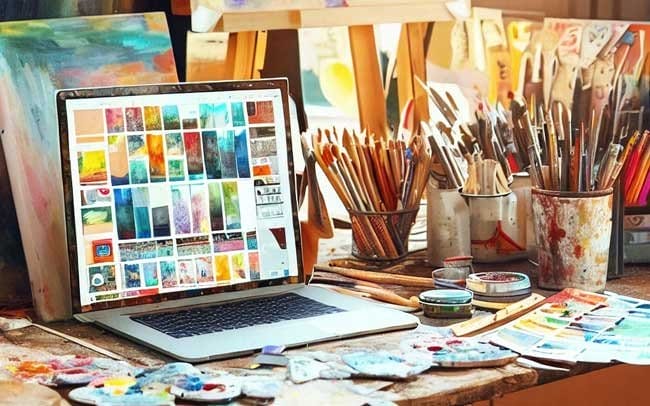In today’s digital age, artists are presented with a plethora of opportunities to showcase their work. Navigating this vast online realm can be overwhelming, but with the right guidance, it becomes a rewarding journey. This guide steps you through the process of how to promote your art online, ensuring every masterpiece finds its rightful spotlight in the global arena.

The Digital Canvas: Why Every Artist Should Prioritize Getting Featured in Blogs and Online Magazines
In today’s digital age, artists are often caught in a whirlwind of creation, promotion, and administration. While the passion for art drives their creativity, the challenge of limited time and resources can hinder their promotional efforts.

Traditional methods like gallery exhibitions, art fairs, and social media promotion require significant time and energy. This is where the power of being featured on online art blogs and magazines comes into play. Here’s why every artist should consider this avenue:
1. Time-Efficient Visibility
- Automated Exposure: Once featured on an online platform, your art continues to gain visibility without any additional effort. Unlike social media, where constant updates are needed to stay relevant, a feature on a blog or magazine remains accessible and can be viewed indefinitely.
- Reach Beyond Borders: The internet is accessible globally. A single feature can introduce your art to audiences from different parts of the world, expanding your reach far beyond local exhibitions or social media followers.
2. Credibility and Validation
- Stamp of Approval: Being selected and featured by a reputable art platform acts as an endorsement of your work. It’s a nod from the art community that your creations are noteworthy.
- Building a Digital Resume: Over time, multiple features can bolster your artist’s CV, showcasing your achievements and elevating your stature in the art world.
3. Networking and Opportunities:
- Connect with Fellow Artists: Online platforms often foster communities. A feature can open doors to collaborations, partnerships, and friendships with other artists.
- Attract Patrons and Galleries: Many art collectors and gallery owners scout for talent online. A feature can act as a beacon, drawing them to your work.
4. Cost-Effective Promotion:
- Free or Low-Cost Features: Many online art platforms offer free submissions or charge a nominal fee. This is often more cost-effective than organizing solo exhibitions or investing heavily in social media advertising.
- Direct Sales Potential: Some platforms allow for direct sales or drive traffic to your personal website, providing an avenue for revenue generation.
5. Overcoming the Limitations of Social Media:
- Algorithm Woes: Social media platforms often rely on algorithms that can limit the visibility of your posts. A feature on an art blog or magazine isn’t bound by such constraints.
- Targeted Audience: While social media caters to a broad audience, art blogs and magazines are frequented by art enthusiasts, collectors, and professionals, ensuring your work is seen by those who truly appreciate it.
The Path Ahead: The benefits of being featured online are clear, especially for artists juggling multiple responsibilities and facing the challenges of self-promotion. In the sections that follow, we’ll guide artists through the steps to master the art of online submission, ensuring their work gets the spotlight it deserves, without overwhelming their schedule.
Understanding the Online Art Landscape

Years ago, artists showcased their work mainly in physical spaces like galleries. Today, the internet offers countless platforms where art can shine. Websites like ArtStation and Behance, for instance, are buzzing with artists sharing their masterpieces. These platforms have become a hub for creativity, where artists from different backgrounds come together to inspire and be inspired.
Types of Platforms
There are several online spots where artists can display their work:
- Art Blogs: These are like online journals where writers discuss art. They often feature artists and their creations. Imagine being spotlighted on a popular blog like “Artistic Realms”! Such blogs not only highlight your work but also provide context, making it relatable to a broader audience.
- Online Magazines: These are digital versions of the magazines you find in stores. They might have sections dedicated to emerging artists. A feature in “Digital Art Weekly” can boost an artist’s profile, giving them a platform that reaches thousands, if not millions.
- Galleries: Some galleries have moved online. They host virtual exhibitions, allowing people from all over the world to view and buy art. This means that someone in Tokyo can admire and purchase a piece from an artist in New York without any barriers.
Why Go Digital?
With just a simple click, your art becomes instantly available to a vast audience, spanning from curious onlookers to dedicated art aficionados across the globe. This widespread accessibility eliminates geographical barriers, ensuring that your creations can be admired without the constraints of location.
The interactive nature of online platforms transforms the artist-viewer relationship. Every post you make can become a dynamic forum for dialogue and exchange. Viewers can share their insights, praises, or constructive critiques, offering artists a continuous stream of feedback. This real-time interaction is akin to having a series of mini art critique sessions, providing invaluable perspectives that can shape an artist’s evolution and refinement.
Finding the Right Art Blogs and Magazines
Navigating the vast digital landscape can be daunting, but with the right strategies, you can pinpoint platforms that are eager to showcase your art. Here’s how:
- Using Search Engines Effectively:
- Start with general terms like “art blogs accepting submissions” or “online art magazines.”
- Refine by adding specific art styles, e.g., “contemporary art blog submissions” or “surrealist art online magazine.“
- Employ search operators for precision, such as “art blog + submissions” to get results specifically related to art blogs with a submission process.
- Leveraging Art Forums and Communities:
- Platforms like DeviantArt, ArtStation, and WetCanvas have forums where artists discuss opportunities and share experiences.
- Engage in Facebook groups or Reddit communities centered around art. These spaces often have members posting calls for submissions or sharing their success stories.
- Recommendations from Fellow Artists:
- Networking is invaluable. Engage with artists on platforms like Instagram (read more) or at local art events. Inquire about their online submission experiences and gather recommendations.
- Participate in webinars, workshops, or online classes. Established artists might share platforms they’ve been featured on.
A Short List to Get You Started:
| Platform/Website | Description |
|---|---|
| Colossal | A platform exploring art, photography, and visual culture. They often feature both emerging and established artists. |
| Booooooom | An art blog that accepts submissions across various disciplines. They recently announced an open call for black & white photography. |
| The Jealous Curator | A curated space showcasing artworks that “make you jealous.” |
| Artists Inspire Artists | A platform where artists can submit their work to inspire their peers. |
| Empty Easel | This blog offers art tutorials and a platform for artists to showcase their work. |
| ArtWeb | A blog by the ArtWeb platform that features artist interviews, art tutorials, and more. They often showcase artists from their community. |
| Hi-Fructose Magazine | An art magazine that focuses on contemporary art. They feature artists from various disciplines and often have open calls for submissions. |
Remember, persistence and research are key. The more platforms you discover and apply to, the higher your chances of getting your work featured. And while rejection is part of the journey, each attempt brings you closer to your goal.
Criteria for Choosing the Right Art Blog
When choosing the right art blogs and magazines to submit your work to, it’s important to consider several factors. These criteria will ensure that your efforts are directed toward platforms that align with your art and goals.
- Audience Size and Engagement:
Audience Size and Engagement are vital metrics to consider when evaluating a platform. Essentially, it measures the number of visitors or readers a platform attracts and the level of interaction they have with the content.
The significance of these metrics lies in the potential visibility they offer your work. A platform with a vast audience can provide extensive exposure but don’t underestimate the power of a smaller, yet highly engaged audience.
For instance, a blog such as “Artistic Odyssey” may not boast the massive monthly visitor numbers of a behemoth like “ArtNet”. Still, its audience could be more dedicated to actively discovering and supporting new artists. - Relevance to Your Art Style and Genre:
It’s a good idea to gauge how well a platform’s content mirrors your art. For instance, while some blogs may emphasize contemporary art, others could have a penchant for traditional forms or specific genres such as surrealism or impressionism.
The significance of this alignment is twofold. Firstly, aligning with platforms tailored to your style boosts your acceptance odds. Secondly, it ensures your art resonates with an audience that genuinely values it. - Submission Guidelines and Acceptance Rate:
Submission guidelines and acceptance rates are vital aspects to consider when approaching a platform. Essentially, they define the platform’s rules for submitting work and provide insight into how often submissions are accepted. Grasping a platform’s acceptance rate helps artists set realistic expectations.
It’s a good idea to choose platforms with transparent guidelines, ensuring that your art submission perfectly matches their criteria. For instance, “Create! Magazine” could offer an in-depth submission page that specifies the formats, sizes, and artwork types they’re open to. A 10% acceptance rate from them not only shows their selectiveness but also their commitment to quality.
Preparing for Submission
Getting your artwork noticed starts with a stellar presentation. Think of it as setting up your own art gallery, but online.
Creating a Digital Portfolio:
Your online portfolio is your art’s home. Platforms like Behance and ArtStation offer spaces where artists can display their masterpieces. For instance, Jane Doe, a contemporary artist, uses her personal website to not only showcase her vibrant paintings but also to share her art journey. Your portfolio should highlight your best pieces, ensuring they represent your style and skill.

Using an Artist’s Media Kit:
An artist’s media kit is a game-changer. It’s a collection of materials that showcase who you are, what you do, and your accomplishments. This kit can include your bio, press releases, and notable mentions. It acts as a bridge, connecting potential publishers or galleries to your world. By linking them to your media kit, you’re offering a comprehensive view of your artistry.
Writing an Artist Statement:
Your art speaks, but sometimes, viewers want to hear your voice too. An artist statement is your chance to share your inspiration and the story behind your work. If you paint abstracts inspired by nature, your statement might read, “Nature’s dance, from the rustling leaves to the flowing rivers, drives my brush strokes, capturing its rhythm and hues.”
Preparing High-Quality Images: A blurry or dim photo can overshadow your artwork’s beauty. Capture clear, well-lit images of your pieces. Using a tripod can ensure stability. Simple editing tools, like those on your smartphone or apps like Snapseed, can refine brightness and contrast. Your art’s online image often sets the first impression, so make it memorable!
With a polished digital portfolio, a comprehensive media kit, a resonating artist statement, and vibrant images, you’re paving the way for successful submission. Give your art the platform it truly deserves.
Use LinkedIn to Approach Blogs and Online Magazines
To increase your chances of getting featured in blogs and online magazines, consider leveraging LinkedIn for Artists as a strategic networking tool. Connect with editors, writers, and contributors of art blogs and magazines through LinkedIn. After establishing these connections, craft a thoughtful and personalized message introducing yourself and your work.
Share your portfolio and articulate your genuine interest in collaborating with their platform. Since LinkedIn is recognized as a professional networking site, this approach not only showcases your professionalism but also positions you in a favorable light when seeking feature opportunities in prominent publications.
Crafting a Successful Application or Request
Submitting your art to online platforms is like opening a door to a world of opportunities. But first, you need the right key!
Every art blog or magazine has its own set of rules. It’s like a puzzle; each piece must fit perfectly. For instance, “Artistic Expressions” magazine might ask for three high-resolution images, while “Canvas Chronicles” could request a short video of your creative process. Always read the guidelines carefully. If they ask for a square image, don’t send a rectangular one. It shows you pay attention to detail.
Your cover letter is your handshake, your introduction. Make it memorable! Start by addressing the person in charge, like “Dear Ms. Smith”. Share a bit about yourself and your passion for art. Mention why you believe your work fits their platform. For example, if you’re applying to a nature-themed art blog, you could write, “My recent collection, ‘Whispers of the Forest’, captures the serene beauty of woodlands, which I believe aligns perfectly with your blog’s theme.”
After sending your application, give it some time. If you don’t hear back in a couple of weeks, it’s okay to send a gentle reminder. Imagine writing, “Hello, I submitted my artwork titled ‘Sunset Dreams’ two weeks ago and wanted to check its status. I’m eager to be a part of your platform.” Remember, persistence is key, but patience is a virtue.
Leveraging Social Media for Your Featured Art
Congratulations! Your art’s been featured on a blog. Now, let’s amplify that success with the power of social media.
1. Share with Authenticity: When posting about your feature, let your genuine excitement shine through. Instead of just saying, “Check out my feature on ArtBlogger,” try, “I’m thrilled to share my journey with ‘Whispers of the Forest’ on ArtBlogger! 🎨✨”
2. Use Engaging Visuals: A captivating image or video grabs attention. Share a behind-the-scenes clip of creating your artwork or a snippet from the blog where you’re featured. Visual stories, like Instagram Stories or Facebook Stories, are perfect for this.
3. Engage with Your Audience: When followers comment or share your post, acknowledge them. A simple “Thank you!” or “Glad you liked it!” fosters a sense of community. Encourage them to visit the blog and leave comments there too.
4. Collaborate with the Blog: Tag the blog or magazine that featured you. They might repost or share your content, leading to even more visibility. If they have a specific hashtag, like #ArtBloggerFeatures, include it in your post.
5. Share Across All Platforms: If you’re on multiple platforms, spread the word everywhere. Tailor your message for each platform’s audience. For instance, on LinkedIn, you might focus on the professional achievement of being featured, while on Instagram, you can share your artistic journey.
6. Schedule Reminder Posts: People might miss your first announcement. Use tools like Buffer or Hootsuite to schedule a few reminder posts over the next weeks. Change up the content a bit each time to keep it fresh.
7. Encourage Sharing: Invite fellow artists, friends, and followers to share your feature. The more shares, the wider your art reaches.
With the right approach, social media can turn your feature into a spotlight moment. Celebrate your success, engage with your community, and watch your art’s influence grow!
Additional Resources
Navigating the art world online can be overwhelming, but with the right resources, you can make the most of your digital presence and opportunities. Here are some tools and readings to help you on your journey:
- Popular Art Blogs and Magazines:
- Artwork Archive: A hub for artists and collectors, offering insights on art storage, business strategies, and legal aspects of the art world. It’s a treasure trove of articles that cater to every artist’s needs.
- Recommended Reading on Art Marketing and Digital Presence:
- “Art/Work: Everything You Need to Know (and Do) As You Pursue Your Art Career” by Heather Darcy Bhandari and Jonathan Melber: This book provides a deep understanding of the art market and how to navigate it.
- “Show Your Work!” by Austin Kleon: A guide that teaches artists how to get discovered using the tools available in the digital age.
- Online Courses and Workshops on Art Photography and Portfolio Creation:
- Coursera’s “Photography Basics and Beyond”: This course takes you from understanding the basics of photography to mastering advanced techniques.

